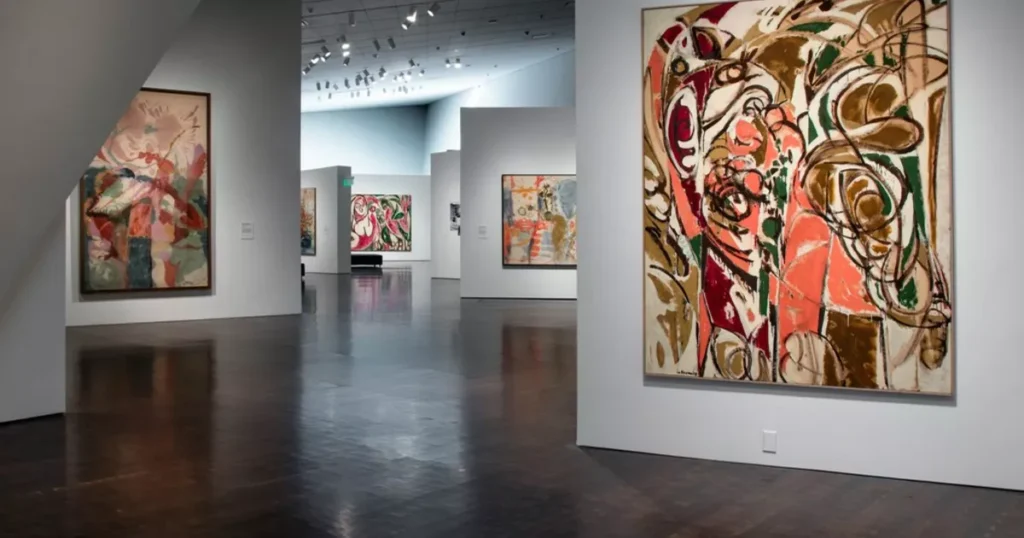In the years following World War II, the world sought to reorganize meanings. Art, as an extension of the spirit of the time, reacted viscerally. It was in this context that Abstract Expressionism emerged, marking a decisive turn in modern art and redefining the relationship between the artist, the gesture, and the canvas.

Far from the formal and rationalist compositions of earlier European art, artists associated with Abstract Expressionism prioritized raw emotion, spontaneous gesture, and the bodily experience of creation. Their works did not merely represent sensations—they embodied them. The surface of the painting ceased to be a space of illusion and became the direct stage for action.
New York Takes Center Stage: Gesture as Language
Until the mid-1940s, Paris was still considered the epicenter of modern art. However, after the war’s impact, New York became a new avant-garde hub.
Although deeply rooted in influences from European Surrealism and psychoanalysis, Abstract Expressionism was the first American art movement to gain international prominence and transform the United States into a global cultural reference.
Artists such as Jackson Pollock, Willem de Kooning, Franz Kline, and Mark Rothko stood out along different paths, but shared a common urgency: to break free from the traditional limits of painting. In Pollock’s case, this break was literal.
He removed the canvas from the easel, placed it on the floor, and walked around it, dripping and pouring paint directly—a process known as dripping. As Harold Rosenberg highlighted in his essay The American Action Painters (1952), the canvas had become “an arena in which to act,” no longer just a surface to represent.
For Rothko, however, the gesture dissolved into chromatic fields. His painting did not rely on direct action. Instead, it aimed to evoke deep emotional states. He used floating forms and colors that seemed to emit light. In both cases, painting was no longer an object. It became an experience. The focus shifted to presence, time, and the viewer’s subjectivity.
According to historian Irving Sandler, Abstract Expressionism constituted a “theory of aesthetic freedom,” where the artist’s gesture was also an act of individual affirmation in a time marked by ideological conflicts and dehumanization (The Triumph of American Painting, 1970). The gesture was therefore not just form—it was content, ethics, and response to the world.
Abstract Expressionism: The Body at the Center of Art
One of Abstract Expressionism’s most impactful contributions was repositioning the body as an active element in artistic production. In contrast to Surrealist automatism or constructive rationality, New York School painters embraced the physicality of painting. It was the artist’s moving body that determined the outcome of the work.
This shift had lasting effects on contemporary art. The idea that process is as important as the final result had wide influence. It shaped happenings in the 1960s. It also impacted performance, installation, and relational art practices. The pictorial surface became a field of confrontation rather than a plane for idealized contemplation.
Recent studies confirm the perceptual power of these works. Researchers at the University of Cambridge analyzed cognitive and emotional responses of visitors facing Pollock and Rothko paintings and identified increased activation in brain areas linked to empathy and affective memory (Neuroaesthetic Engagement with Abstract Expressionism, 2022). Painting ceased to be merely seen; it was felt as a bodily presence.
Moreover, modern criticism came to recognize that despite the absence of recognizable figures, Abstract Expressionism was not devoid of meaning.
The movement’s intensity also opened discussions about masculinity, power, and exclusion in the art world. For decades, figures like Lee Krasner, Joan Mitchell, and Helen Frankenthaler were marginalized in the official narrative despite their central contributions.
Fortunately, recent studies have begun to redress this erasure, as shown by the Women of Abstract Expressionism research published by the Denver Art Museum in 2016.

More than a style, Abstract Expressionism was a linguistic shift. A way of painting that no longer sought to represent the external world but to shape inner turmoil. A movement where paint flowed like thought, color vibrated like tension, and the canvas surface became an extension of body and mind.



